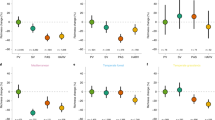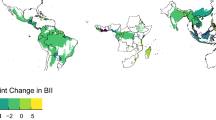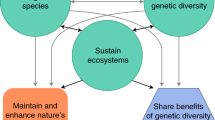Abstract
The nations of the world have set themselves a target of reducing the rate of biodiversity loss by 2010. Here, we propose a biodiversity intactness index (BII) for assessing progress towards this target that is simple and practical—but sensitive to important factors that influence biodiversity status—and which satisfies the criteria for policy relevance set by the Convention on Biological Diversity. Application of the BII is demonstrated on a large region (4 × 106 km2) of southern Africa. The BII score in the year 2000 is about 84%: in other words, averaged across all plant and vertebrate species in the region, populations have declined to 84% of their presumed pre-modern levels. The taxonomic group with the greatest loss is mammals, at 71% of pre-modern levels, and the ecosystem type with the greatest loss is grassland, with 74% of its former populations remaining. During the 1990s, a population decline of 0.8% is estimated to have occurred.
This is a preview of subscription content, access via your institution
Access options
Subscribe to this journal
Receive 51 print issues and online access
$199.00 per year
only $3.90 per issue
Buy this article
- Purchase on Springer Link
- Instant access to full article PDF
Prices may be subject to local taxes which are calculated during checkout


Similar content being viewed by others
References
WCMC Global Biodiversity: Earth's Living Resources in the 21st Century (World Conservation Press, Cambridge, UK, 2000)
Anderson, J. A. (ed.) Towards Gondwana Alive: Promoting Biodiversity and Stemming the Sixth Extinction (Gondwana Alive Society, Pretoria, South Africa, 2001)
UN World Summit on Sustainable Development: Johannesburg Plan of Implementation (United Nations, New York, 2002)
The Royal Society Measuring Biodiversity for Conservation (The Royal Society, London, 2003)
Reid, W. V., McNeely, J. A., Tunstall, D. B., Bryant, D. A. & Winograd, M. Biodiversity Indicators for Policy Makers (World Resources Institute, Washington DC, 1993)
CBD Proposed Biodiversity Indicators Relevant to the 2010 Target (Convention on Biological Diversity, Montreal, 2003)
Noss, R. F. Indicators for monitoring biodiversity: A hierarchical approach. Conserv. Biol. 4, 355–364 (1990)
CBD Monitoring and Indicators: Designing National-Level Monitoring Programmes and Indicators (Convention on Biological Diversity, Montreal, 2003)
Magurran, A. E. Measuring Biological Diversity (Blackwell, Oxford, 2004)
Hilton-Taylor, C. (ed.) 2000 IUCN Red List of Threatened Species (IUCN, Gland, Switzerland and Cambridge, UK, 2000)
IUCN & UNEP World Database on Protected Areas (IUCN & UNEP, Cambridge, UK, 2003)
Loh, J. (ed.) Living Planet Report 2002 (WWF International, Gland, Switzerland, 2002)
Sanderson, E. W. et al. The human footprint and the last of the wild. Bioscience 52, 891–904 (2002)
Jenkins, M. Prospects for biodiversity. Science 302, 1175–1177 (2003)
Houghton, J. T. et al. (eds) Revised 1996 IPCC Guidelines for National Greenhouse Gas Inventories (UK Meteorological Office, Bracknell, 1997)
Armstrong, A. J. & van Hensbergen, H. J. Comparison of avifaunas in Pinus radiata habitats and indigenous riparian habitat at Jonkershoek, Stellenbosch. S. Afr. J. Wildl. Res. 24, 48–55 (1994)
Dean, W. R. J., Anderson, M. D., Milton, S. J. & Anderson, T. A. Avian assemblages in native Acacia and alien Prosopis drainage line woodland in the Kalahari, South Africa. J. Arid Environ. 51, 1–19 (2002)
Fabricius, C., Burger, M. & Hockey, P. A. R. Comparing biodiversity between protected areas and adjacent rangeland in xeric succulent thicket, South Africa: arthropods and reptiles. J. Appl. Ecol. 40, 392–403 (2003)
Herremans, M. Conservation status of birds in Botswana in relation to land use. Biol. Conserv. 86, 139–160 (1998)
Johnson, R., Ferguson, J. W. H., van Jaarsveld, A. S., Bronner, G. N. & Chimimba, C. T. Delayed responses of small-mammal assemblages subject to afforestation-induced grassland fragmentation. J. Mamm. 83, 290–300 (2002)
Joubert, D. F. & Ryan, P. G. Differences in mammal and bird assemblages between commercial and communal rangelands in the Succulent Karoo, South Africa. J. Arid Environ. 43, 287–299 (1999)
Meik, J. M., Jeo, R. M., Mendelson, J. R. III & Jenks, K. E. Effects of bush encroachment on an assemblage of diurnal lizard species in central Namibia. Biol. Conserv. 106, 29–36 (2002)
Parsons, D. A. B., Shackleton, C. M. & Scholes, R. J. Changes in herbaceous layer condition under contrasting land use systems in the semi-arid lowveld, South Africa. J. Arid Environ. 37, 319–329 (1997)
Richardson, D. M. & van Wilgen, B. W. Effects of thirty-five years of afforestation with Pinus radiata on the composition of mesic mountain fynbos near Stellenbosch. S. Afr. J. Bot. 52, 309–315 (1986)
Shackleton, C. M. Comparison of plant diversity in protected and communal lands in the Bushbuckridge lowveld savanna, South Africa. Biol. Conserv. 94, 273–285 (2000)
Smart, R., Whiting, M. J. & Twine, W. Lizards and landscapes: Integrating field surveys and interviews to assess the impact of human disturbance on lizard assemblages and selected reptiles in a savanna in South Africa. Biol. Conserv. 122, 23–31 (2005)
WWF-US Species Database for African Ecoregions (WWF Conservation Science Programme, Washington DC, 2003)
Olson, D. M. et al. Terrestrial ecoregions of the world: A new map of life on earth. Bioscience 51, 933–938 (2001)
FAO FAOSTAT Agricultural Databasehttp://apps.fao.org (2004).
FAO Global Forest Resources Assessment 2000 (Food and Agriculture Organisation of the United Nations, Rome, 2001)
Le Roux, J. (ed.) The Biodiversity of South Africa 2002: Indicators, Trends and Human Impacts (Struik, Cape Town, 2002)
Friedmann, Y. & Daly, D. (eds) Red Data Book of the Mammals of South Africa: a Conservation Assessment (IUCN Conservation Breeding Specialist Group & Endangered Wildlife Trust, Johannesburg, South Africa, 2004)
CSIR National Land Cover of South Africa (Council for Scientific and Industrial Research, Division of Water, Environment and Forestry Technology, Pretoria, South Africa, 1996)
CSIR Protected Areas of South Africa (Department of Environmental Affairs and Tourism, Pretoria, South Africa, 2003)
Ten Brink, B. J. E. et al. Technisch ontwerp Natuurwaarde 1.0 en toepassing in Natuurverkenning 2 [Technical design Natural Capital Index framework and implementation for the Nature Outlook 2] (RIVM, Bilthoven, The Netherlands, 2002)
CSIR SADC Landcover Dataset (Council for Scientific and Industrial Research, Division of Water, Environment and Forestry Technology, Pretoria, South Africa, 2002)
EC Global Land Cover 2000 (GLC2000) Database (European Commission Joint Research Centre, Ispra, Italy, 2003)
CIESIN IFPRI & CIAT Global Rural-Urban Mapping Project (GRUMP): Urban Extents (CIESIN, Columbia Univ., Palisades, 2004)
Acknowledgements
We thank the following experts whom we interviewed: G. Alexander, G. Bredenkamp, D. Biggs, B. Branch, V. Carruthers, A. Channing, C. Chimimba, J. du Toit, W. Haacke, J. Harrison, M. Keith, L. Minter, M. Rutherford, W. Tarboton and M. Whiting. R. Dean, C. Geldenhuys, B. Reyers, H. Simons, B. van Wilgen and M. Whiting are thanked for providing links to literature studies for validation of the expert estimates. We thank N. Burgess, J. D'Amico and the Conservation Science Programme at WWF, and G. Kier and the Biomap Working Group at the University of Bonn, Germany, for species richness data. J. Harrison is thanked for data used to derive the richness of each taxon functional type per biome. Thank you to D. van Zyl and T. Newby at the Institute for Soil, Climate and Water in Pretoria for the maximum annual normalized difference vegetation index (NDVI) data that were used to map degradation. B. Reyers at the University of Stellenbosch is thanked for the summation of the mammal distribution grids, which were provided by M. Keith. R.J.S. conceived the original idea for the index. It was then jointly developed further, and the paper was co-written by the authors. R.B. did the BII calculations, GIS application and literature validation.
Author information
Authors and Affiliations
Corresponding author
Ethics declarations
Competing interests
The authors declare that they have no competing financial interests.
Rights and permissions
About this article
Cite this article
Scholes, R., Biggs, R. A biodiversity intactness index. Nature 434, 45–49 (2005). https://doi.org/10.1038/nature03289
Received:
Accepted:
Issue Date:
DOI: https://doi.org/10.1038/nature03289
This article is cited by
-
The bii4africa dataset of faunal and floral population intactness estimates across Africa’s major land uses
Scientific Data (2024)
-
Feeding climate and biodiversity goals with novel plant-based meat and milk alternatives
Nature Communications (2023)
-
Insect diversity is a good indicator of biodiversity status in Africa
Communications Earth & Environment (2023)
-
The Urban Circularity Assessment Framework (UCAF): a Framework for Planning, Monitoring, Evaluation, and Learning from CE Transitions in Cities
Circular Economy and Sustainability (2023)
-
Land-use-driven biodiversity impacts of diets—a comparison of two assessment methods in a Finnish case study
The International Journal of Life Cycle Assessment (2023)
Comments
By submitting a comment you agree to abide by our Terms and Community Guidelines. If you find something abusive or that does not comply with our terms or guidelines please flag it as inappropriate.



